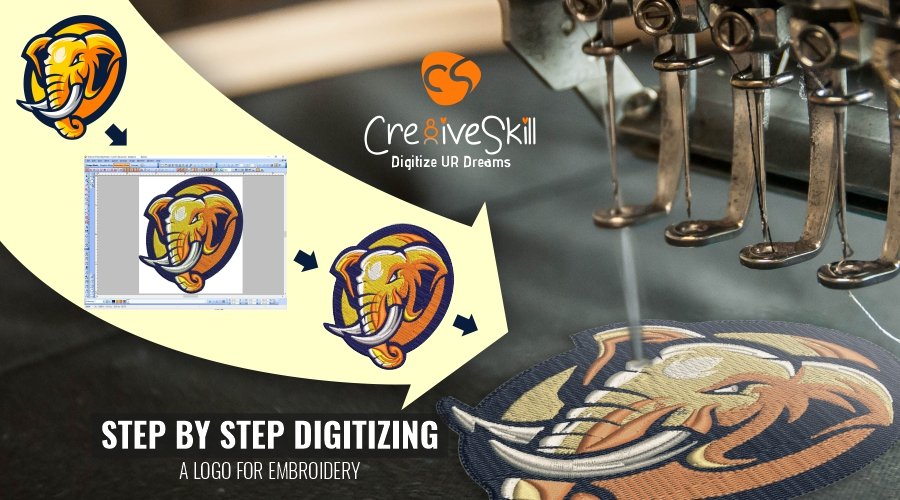Simplifying the Art of Embroidery Digitizing: Step-by-Step Guide
As technology proceeds to advance, the digitization procedure has become extra accessible, allowing enthusiasts to bring their intricate layouts to life with convenience. In this guide, we will untangle the intricacies of embroidery digitizing, breaking down each step systematically to improve the procedure and encourage both novices and seasoned embroiderers alike.
Comprehending Embroidery Digitizing Software
Embroidery digitizing software application acts as an essential tool for transforming elaborate styles into digital layouts compatible with embroidery devices, promoting accurate stitching and modification. This specialized software program enables users to import numerous picture documents styles, such as JPG or PNG, and convert them into embroidery machine-readable layouts like DST, EXP, or PES - Digitizing for Embroidery. By utilizing attributes like stitch editing and enhancing, rug alternatives, and thread shade selection, digitizing software makes it possible for individuals to manage every element of the style process
In addition, progressed needlework digitizing software uses tools for developing complex designs, changing stitch density, and incorporating intricate details. Customers can additionally preview the design prior to sewing it out, making certain precision and decreasing mistakes. Additionally, many software programs provide automated attributes that aid enhance the digitizing procedure, saving effort and time.
Understanding the capacities of embroidery digitizing software is necessary for accomplishing premium cause needlework tasks. By understanding this device, embroidery fanatics and experts can release their imagination and bring intricate layouts to life with accuracy and efficiency.

Picking the Right Style File
After familiarizing yourself with the capacities of needlework digitizing software, the following important action in the procedure is choosing the appropriate style apply for your project. Digitizing for Embroidery. When picking a style apply for needlework digitizing, it's essential to think about the intricacy of the design, the size of the last product, and the kind of textile you will be working with
For detailed designs with great information, a high-resolution picture or vector data is advised to guarantee that the embroidery machine can precisely duplicate the design. Additionally, the dimension of the last item plays a considerable role in selecting the appropriate layout data. Larger styles may need greater resolution files to keep clarity and sharpness.
In addition, the sort of textile you will certainly be stitching on affects the selection of design documents. Various textiles may need modifications in the style documents to guarantee that the stitches are properly aligned and the style appears as planned. By carefully choosing the appropriate design documents based upon these variables, you can establish yourself up for an effective embroidery digitizing procedure.
Digitizing Devices and Strategies
Using specialized software application and precision methods, digitizing devices are essential in changing complex styles right into embroidery-ready files. Needlework digitizing software application, such as Wilcom, Hatch, or Embrilliance, supplies the needed platform to convert artwork into stitch data. These programs use functions like stitch editing, rug choices, and lettering devices to make certain the design converts flawlessly onto textile.
One of the essential techniques in digitizing is developing a clear course for the embroidery equipment to adhere to. This includes digitizing each aspect of the style with precision, identifying stitch kinds, densities, and directions. By utilizing devices like digitizing tablets or software-specific plugins, embroiderers can attain a high degree of accuracy in their digitized styles.
Additionally, understanding the art of rug sewing is essential for producing high quality embroidery. Underlay stitching stabilizes the material and produces a foundation for the design, guaranteeing that the last item is both visually appealing and durable. By recognizing these digitizing devices and methods, embroiderers can elevate their craft and bring intricate designs to life with precision and performance.
Customizing Stitch Types and Instructions
Having actually established a foundation in digitizing devices and techniques, a critical facet ahead of time embroidery craftsmanship hinges on customizing stitch types and instructions with accuracy and objective. The option of stitch kinds can dramatically influence the overall look and appearance of the stitched layout. Satin stitches, understood for their smooth and shiny surface, job well for developing borders and message. On the various other hand, fill stitches are excellent for covering bigger areas efficiently. By tactically incorporating these stitch kinds, embroiderers can achieve depth and dimension in their designs.
Moreover, the direction of stitches plays an essential function in improving the aesthetic allure of the last embroidery. Numerous stitch directions can add texture, highlight specific aspects, and produce visual passion. Changing the angle Clicking Here of stitches can replicate movement or all-natural patterns like fur or feathers. By try out different stitch angles and patterns, embroiderers can bring their layouts to life with remarkable detail and ins and out. Grasping the art of personalizing stitch types and instructions empowers embroiderers to unleash their creative thinking and browse this site raise the high quality of their job.
Screening and Refining Your Digitized Style
To make certain the precision and high quality of your digitized style, comprehensive testing and refinement are necessary action in the embroidery digitizing process. When you have actually completed the digitization of your design, it is important to check it before continuing with the actual needlework. Evaluating allows you to determine any kind of potential problems such as string breaks, sew density problems, or style distortions that may impact the outcome.

After screening, it is necessary to fine-tune your digitized style based upon the responses from the examination sew-out. This might include tweaking stitch settings, changing densities, or making modifications to the overall layout to attain the desired outcome. By repeating via testing and refinement, you can fine-tune your digitized design to excellence before moving forward with the real needlework process.
Final Thought
Finally, grasping the art of embroidery digitizing needs a detailed understanding of the software, picking the best style data, utilizing digitizing devices and methods, customizing stitch kinds and directions, and testing and improving the digitized design. you can find out more By complying with these steps, embroiderers can streamline the digitizing procedure and produce top quality stitched styles with precision and efficiency.